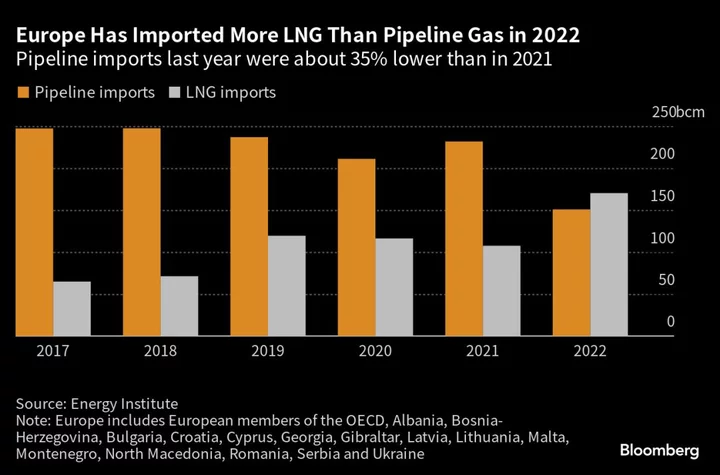Europe’s liquefied natural gas imports surpassed those coming to the continent via pipelines for the first time last year, according to data from the Energy Institute.
The shift signals that the continent is rebuilding its energy infrastructure quickly while breaking ties with Russia after the invasion of Ukraine. The reversal is even more meaningful since global gas production remained relatively constant in 2022, compared with a year earlier, the EI’s annual statistical review of world energy shows.
Europe was a premium market, which helped lure more LNG to its shores and fill the gaps left by dwindled Russian pipeline supply. That shift led to record prices and volatility in gas markets, as well as persistent inflation across the continent, depressing industrial activity amid an economic slowdown.
The war in Ukraine upended “assumptions about supply around the world,” said Nick Wayth, the London-based institute’s chief executive officer. The shifts “precipitated a price crisis and profound cost-of-living pressures across many economies.”
During the year, European nations swiftly installed more import terminals for the super-chilled fuel, with Germany joining the importers’ club for the first time. The region’s utilities signed accords to bring in more LNG from producers such as the US, and there was a pivot toward renewable sources such as wind and solar.
European pipeline gas imports last year were about 151 billion cubic meters, compared with 232 billion a year earlier, according to the statistical review. The 35% year-on-year drop contrasts with LNG imports, which increased to 170 billion cubic meters in 2022 from 108 billion a year earlier.
While Europe’s appetite for LNG increased, Asia was still the biggest importer of that fuel. Global trade of gas as LNG represented 56% of all inter-regional traded gas last year, according to the review.
Russia’s share of global pipeline exports fell to 29% in 2022 from about 43% on average over the previous 10 years, the report said.
Norwegian pipeline gas was counted as internal trade within Europe and excluded from the imports number.
--With assistance from Elena Mazneva.
(Adds detail on Russia exports in eighth paragraph)

